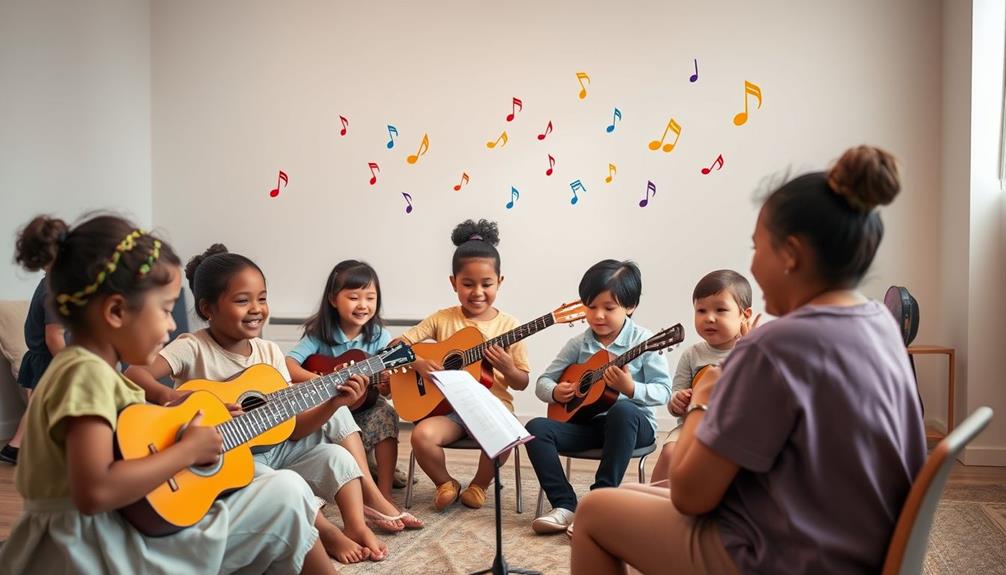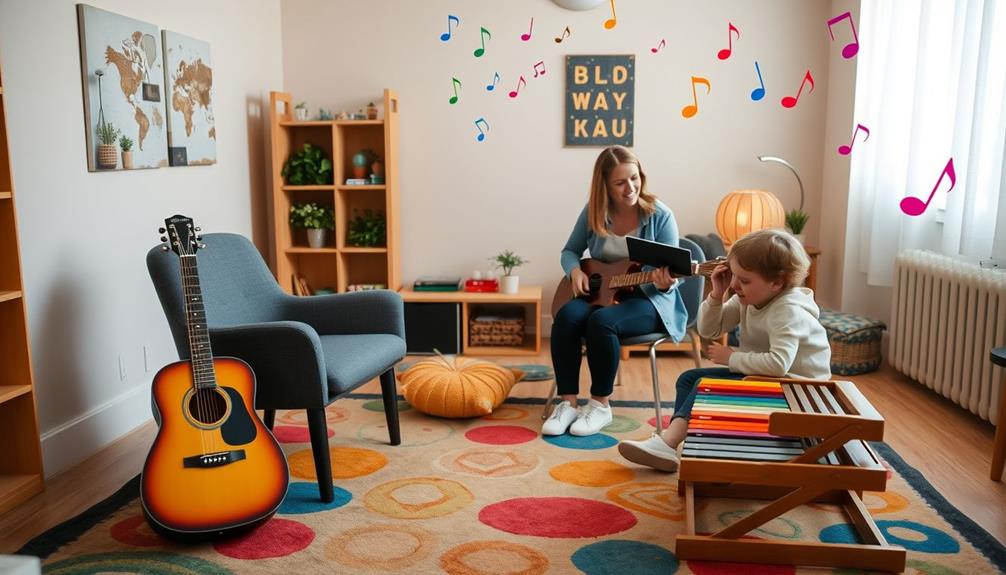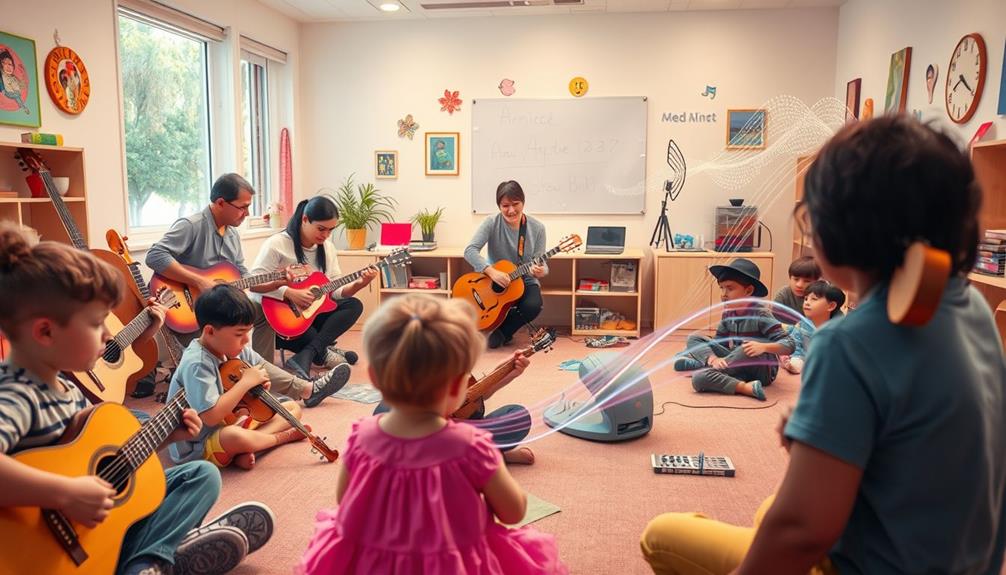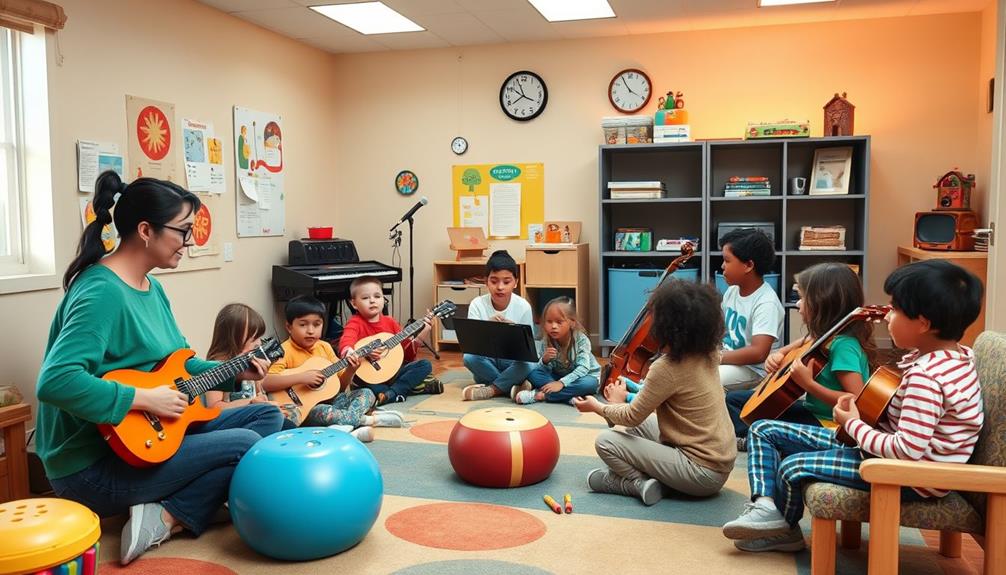Music therapy's a powerful tool for individuals with Autism Spectrum Disorder (ASD). It boosts social skills and emotional regulation while creating a fun, engaging environment. Through techniques like improvisation and rhythmic entrainment, you can see improvements in communication and coordination. It's particularly effective in enhancing parent-child relationships, making sessions more rewarding. Many families find that music therapy not only aids development but also strengthens family bonds. If you're curious about how this therapy can specifically benefit your loved one or want to explore techniques used, there's a lot more to uncover.
Key Takeaways
- Music therapy enhances communication, social skills, and emotional regulation in individuals with Autism Spectrum Disorder (ASD).
- Techniques such as rhythmic entrainment and improvisation promote social interaction and non-verbal communication.
- Family involvement in music therapy strengthens parent-child relationships and boosts children's engagement.
- Research indicates music therapy improves social reactions and interaction, although it shows limited effects on symptom severity.
- Future studies aim to validate long-term benefits of music therapy and include diverse participant populations for broader applicability.
Understanding Autism Spectrum Disorder
Autism Spectrum Disorder (ASD) is a complex neurodevelopmental condition that affects about 1% of people worldwide. This neurodevelopmental disorder presents challenges primarily in social communication, making it difficult for individuals with ASD to navigate social interactions and develop essential social skills. Symptoms can vary widely, ranging from profound disabilities to high-functioning capabilities, and many individuals require different levels of support in their daily lives.
Early intervention is crucial, as research shows that addressing communication disorders and enhancing social communication skills can markedly improve developmental trajectories. Dog training schools can offer valuable insights into effective communication strategies that may also benefit individuals with ASD.
Children diagnosed with ASD often exhibit difficulties with emotional regulation, which can lead to challenges in managing feelings and reactions in various situations.
As the prevalence of autism spectrum disorder continues to rise, with estimates indicating 60 to 157 cases per 10,000 children, understanding these challenges becomes even more important. By recognizing the unique needs of individuals with ASD, caregivers and professionals can provide the necessary support to foster better social engagement and emotional health.
This understanding is a crucial step toward creating effective strategies to help those on the spectrum thrive in their environments.
What Is Music Therapy?

Music therapy is a dynamic and systematic intervention that harnesses the power of musical experiences to promote health and enhance communication skills, especially in individuals with autism spectrum disorder (ASD). This therapeutic approach uses various techniques, such as improvisation, singing, and playing instruments, tailored to suit each individual's unique needs.
Incorporating stress management techniques can further enhance the effectiveness of music therapy by providing individuals with tools to regulate their emotions. In music therapy, you'll find a structured environment where social interaction can flourish. Research shows that it can lead to significant improvements in social reactions among children with ASD, evidenced by a standardized effect size of 0.24.
By engaging in musical experiences, individuals with autism can develop better emotional regulation and address sensory sensitivities in a safe space.
Moreover, music therapy isn't just effective; it's also cost-effective and noninvasive, making it a valuable adjunct to standard therapies. While its efficacy continues to require further validation through rigorous research, the current techniques and approaches show promise in enhancing communication skills and fostering connections among individuals with autism.
Ultimately, music therapy can be a transformative tool, allowing individuals to express themselves and interact in ways that mightn't be possible through traditional methods.
Benefits of Music Therapy

Engaging in music therapy offers numerous benefits that can greatly enhance the lives of individuals with autism spectrum disorder (ASD). This therapeutic approach has shown to improve communication skills and social interaction, allowing children to connect better with those around them.
Additionally, understanding the emotional needs of children can help caregivers provide better support; for instance, studies indicate that cats show signs of separation anxiety when owners leave, highlighting the importance of emotional attachment in fostering connections cats show emotional attachment.
With the use of individualized interventions, music therapy can considerably enhance non-verbal communication (SMD = 0.57) and encourage initiating behavior (SMD = 0.73).
Here are some emotional benefits you might witness:
- Improved emotional regulation, reducing anxiety in sensory-sensitive children.
- Strengthened parent-child relationships through shared musical experiences.
- Enhanced social adaptation skills, making daily interactions smoother.
- Increased engagement during therapy sessions, fostering a sense of belonging.
The tailored nature of music therapy not only promotes social adaptation (SMD = 0.41) but also leads to long-term improvements in overall quality of life.
As you see your child thrive in this supportive environment, you'll likely notice improvements in their coping strategies and social reactions (SMD = 0.24).
Techniques Used in Music Therapy

In music therapy, you'll find various techniques that can greatly benefit children with autism. Rhythmic entrainment helps improve coordination and social skills, while improvisation and composition encourage emotional expression.
Additionally, structured sensory experiences offer tailored support to address individual sensory needs. Techniques such as auditory discrimination exercises can also enhance sound processing abilities, further supporting communication development in children with autism.
Rhythmic Entrainment Benefits
Through rhythmic entrainment, children with autism can experience significant benefits that enhance their engagement and development. This technique in music therapy utilizes rhythm to synchronize movements, improving motor skills and coordination.
Activities like drumming and moving to a steady beat not only enhance physical abilities but also promote social interaction, encouraging children to participate in cooperative play. By fostering connections through shared musical experiences, children can build relationships with their peers during therapy sessions.
Here are some emotional benefits you might notice:
- Increased focus: Rhythmic entrainment helps improve attention, keeping children engaged in the moment.
- Enhanced communication: This technique facilitates non-verbal cues and expressive gestures, boosting communication skills.
- Emotional stability: It provides a structured sensory experience, aiding emotional regulation and managing anxiety.
- Stronger connections: Children learn to interact with others, fostering meaningful social interactions.
Improvisation and Composition Techniques
Many children with autism find joy and freedom in improvisation and composition techniques during music therapy. These approaches allow you to express yourself creatively and emotionally through spontaneous music creation, greatly enhancing your communication skills and emotional awareness.
Incorporating elements from yoga for back pain management, such as breathing exercises, can further enhance relaxation and focus during these sessions. When you engage in improvisation, especially in group settings, it promotes social interaction and turn-taking, which helps build peer relationships and collaborative skills.
Composition techniques encourage you to create your own songs, fostering self-confidence and a sense of ownership over your musical expression. These personalized creations not only empower you but also give you a platform to articulate your feelings.
Additionally, structured improvisational activities can improve your motor skills and coordination as you synchronize your movements to musical rhythms using instruments like drums and shakers.
Structured Sensory Experiences
Structured sensory experiences are frequently utilized in music therapy to engage children with autism in meaningful ways. These experiences harness techniques like rhythmic entrainment, which uses consistent beats to enhance coordination and motor skills.
Additionally, incorporating elements such as essential oils for relaxation can further support a calming environment, addressing sensory sensitivities while fostering emotional regulation and reducing anxiety.
Consider the impact of structured sensory experiences:
- Children find joy in rhythmic patterns, feeling a sense of belonging.
- Music becomes a bridge for emotional expression, allowing feelings to surface.
- Group music-making sessions create crucial opportunities for social interaction.
- Playing instruments together builds essential turn-taking and cooperative skills.
Research Findings on Music Therapy

While recent research highlights the potential benefits of music therapy for children with autism spectrum disorder (ASD), the findings present a mixed picture. Some studies suggest that music therapy can improve social interaction and communication skills in children with ASD, while others show no significant effects. The effectiveness of music therapy may depend on the individual’s level of functioning and the specific music therapy approach used. Further research is needed to better understand how different music therapy interventions can best support children with ASD.
A systematic review of randomized controlled trials (RCTs) showed that music therapy considerably increased social reactions in children with ASD, with a standardized mean difference (SMD) of 0.24 (P = 0.03). This review analyzed eight RCTs involving 608 participants, focusing on social interaction measured by the Social Reaction Scale (SRS).
Additionally, studies on dog training suggest that activities involving pets can also enhance social skills in children with ASD.
Curiously, music therapy didn't demonstrate notable effects on symptom severity (SMD = 0.17, P = 0.12) or improvements in social adaptive behavior (SMD = 0.02, P = 0.93) and speech production (SMD = 0.04, P = 0.86).
However, ten studies indicated music therapy's superiority in promoting social interaction within therapy contexts, showing an impressive SMD of 1.06 and general social interaction improvements (SMD 0.71).
Limitations in the current research include small sample sizes and variable evidence quality, which highlight the need for larger studies to validate the effectiveness of music therapy in enhancing communication skills and social interaction in children with ASD.
Integrating Music Therapy Into Treatment

Integrating music therapy into your child's treatment means using evidence-based practices to create individualized plans that truly meet their needs.
By incorporating family activities that promote creativity, you can enhance the therapeutic process and make it more engaging for your child.
By collaborating with other professionals, you can guarantee a thorough approach that targets social skills and emotional regulation.
This teamwork not only enhances the therapy experience but also supports your child's overall development.
Evidence-Based Practices
Music therapy plays an essential role in evidence-based practices for treating Autism Spectrum Disorder (ASD). By integrating music therapy into treatment, you can enhance social interactions and improve communication skills in children with ASD.
Systematic reviews show that music therapy notably impacts these areas, with standardized mean differences (SMD) highlighting its effectiveness. Research indicates that early intervention, similar to mental health support, can lead to better outcomes in overall development.
- Experience the joy of improved social connections.
- Witness enhanced verbal and non-verbal communication abilities.
- Feel the bond strengthen between parents and children.
- Embrace a multidisciplinary approach tailored to each child's unique needs.
The evidence supports the idea that music therapy can foster communication skills—0.33 for verbal and 0.57 for non-verbal communication. Additionally, you can see moderate results for social adaptation and parent-child relationship quality.
However, future research is vital to validate the long-term effects of music therapy. Larger sample sizes and standardized outcome measures will help solidify its place in the evidence base for ASD treatment.
Individualized Treatment Plans
Individualized treatment plans for children with Autism Spectrum Disorder (ASD) incorporate music therapy to meet each child's unique needs and preferences. These plans are tailored to enhance communication skills and social interaction through various music therapy techniques, including improvisation, singing, and listening. By integrating these methods into the overall treatment strategy, you can promote emotional expression and social engagement.
| Component | Description | Benefits |
|---|---|---|
| Therapeutic Goals | Set based on the child's specific needs | Focused development and progress |
| Progress Tracking | Regular evaluations to adjust interventions | Maximizes effectiveness |
| Family Involvement | Collaboration with families and professionals | Guarantees a thorough approach |
As you engage in the therapy process, remember that regular progress tracking is essential. This allows music therapists to modify interventions as necessary, guaranteeing that each child's therapeutic goals are being met. Additionally, family involvement plays a significant role in creating impactful individualized treatment plans, reinforcing the collaborative nature of the therapeutic journey.
Collaborative Therapy Approaches
Collaboration among professionals is key to effectively incorporating music therapy into treatment for children with Autism Spectrum Disorder (ASD). By employing collaborative therapy approaches, you can witness the incredible benefits of teamwork among music therapists, speech-language pathologists, and other experts. Together, they create thorough, individualized treatment plans tailored to each child's unique needs.
Understanding the impact of emotional dynamics in relationships, including those influenced by narcissistic behaviors, can further enhance these approaches.
- Strengthen emotional bonds between children and their caregivers.
- Enhance communication skills through engaging musical activities.
- Foster a supportive environment for holistic development.
- Improve the quality of parent-child relationships.
Family-centered music therapy is particularly effective, as it includes the entire family in sessions, which enhances therapeutic outcomes. A multidisciplinary approach allows you to explore various therapeutic techniques, enriching the treatment experience.
Regular evaluations guarantee that therapy remains aligned with individual goals, maximizing the benefits of music therapy.
As you integrate music therapy into existing treatment models, you'll likely notice significant improvements in social interactions and communication. By embracing these collaborative strategies, you're not just supporting a child with ASD; you're nurturing their potential for growth and connection.
Parental Involvement in Therapy

Parental involvement in music therapy plays a crucial role in enhancing the therapeutic experience for children with Autism Spectrum Disorder (ASD). When you engage in family-centered music therapy, you not only strengthen your bond with your child but also contribute to their emotional development. This shared musical experience creates a supportive environment that fosters better communication skills and social interaction.
By participating in therapy sessions, you can reinforce the skills your child learns, helping them apply these techniques in everyday life. Your involvement allows for tailored therapy interventions that meet your child's unique needs, leading to more effective outcomes. Research shows that when parents actively participate, children demonstrate increased motivation and engagement. This enthusiasm can appreciably enhance their progress in developing crucial social skills.
Moreover, providing feedback and participating in goal-setting guarantees the therapy aligns with your family's dynamics and aspirations. As you work together with therapists, you create a collaborative atmosphere that benefits not just your child but your entire family.
Ultimately, your involvement in music therapy can pave the way for a more enriching experience, positively impacting your child's growth and development.
Challenges and Limitations

While family involvement can greatly enhance the music therapy experience for children with Autism Spectrum Disorder (ASD), it's important to acknowledge the challenges and limitations that exist within the current research.
Many studies suffer from methodological weaknesses, including small sample sizes and issues with randomization and blinding. This makes it tough to draw solid conclusions about the effectiveness of music therapy.
The lack of standardized assessment tools specifically designed for evaluating music therapy's impact on individuals with ASD further complicates matters. Without these tools, quantifying effectiveness becomes a formidable task.
Additionally, the prevalence of publication bias—where most studies are published in English—limits the findings' applicability to diverse populations.
Moreover, the absence of long-term follow-up data means you can't easily grasp the sustained effects of these interventions on communication skills and symptom severity.
- Many families are left wondering about the real benefits.
- Children might miss out on essential developmental opportunities.
- Therapists struggle to provide evidence-based recommendations.
- The community faces uncertainty surrounding effective therapy options.
Addressing these limitations requires rigorous studies with larger populations and pre-registered protocols to enhance our understanding of music therapy for ASD.
Future Directions for Research

As you explore future directions for research in music therapy for Autism Spectrum Disorder, consider the importance of long-term effectiveness studies.
You'll want to prioritize diverse participant inclusion to guarantee findings are applicable across different demographics.
Additionally, developing standardized assessment tools will help quantify the impact of music therapy more accurately and reliably.
Long-term Effectiveness Studies
When it comes to understanding the long-term effectiveness of music therapy for children with Autism Spectrum Disorder (ASD), future research must take a more robust approach.
To truly capture the benefits, studies should focus on larger sample sizes and longer treatment durations. This will help provide stronger evidence of music therapy's impact on social skills and communication over time.
To evoke emotion and highlight the importance of this research, consider the following:
- The joy of a child expressing themselves through music.
- The relief parents feel when their child connects with others.
- The hope of improved communication in everyday life.
- The pride of a child mastering a new social skill.
Using rigorous randomized controlled trials (RCTs) will address existing methodological limitations and biases in current studies.
Additionally, the development of targeted assessment tools, like the Individual Music-Centered Assessment Profile for Neurodevelopmental Disorders (IMCAP-ND), can enhance our understanding of music therapy's effects.
Diverse Participant Inclusion
To truly understand the impact of music therapy on Autism Spectrum Disorder (ASD), researchers must prioritize diverse participant inclusion. By engaging diverse participant groups, studies can evaluate the effectiveness of music therapy interventions across various demographics, including age, gender, and cultural backgrounds.
This approach is essential for evaluating how music therapy can address the unique needs of individuals with ASD, especially those with co-occurring conditions like anxiety or ADHD.
Investigating the effects of music therapy in different settings—such as schools and community centers—can also enhance our understanding of how these interventions can be adapted to diverse environments. Incorporating longitudinal studies with diverse populations will help uncover the long-term benefits of music therapy on social skills and emotional regulation in children with ASD.
Additionally, it's important to engage underrepresented groups in music therapy research. Doing so addresses potential biases in current studies and fosters a more thorough understanding of music therapy's effects on autism.
Standardized Assessment Tools
Developing standardized assessment tools is essential for advancing research on music therapy for children with Autism Spectrum Disorder (ASD). The Individual Music-Centered Assessment Profile for Neurodevelopmental Disorders (IMCAP-ND) represents a significant step towards evaluating the connection between music therapy and ASD.
However, the current methodological quality of studies often limits findings and raises concerns about bias.
Future research must prioritize the creation of standardized assessment tools that provide objective measures of music therapy's effectiveness, particularly concerning social skills and symptom severity. This won't only enhance the reliability of findings but also foster a deeper understanding of how music therapy influences communication and social interaction among children with ASD.
Consider the impact of effective assessment tools:
- They can validate the transformative power of music therapy.
- They offer hope for improved social skills in children with ASD.
- They guarantee every child's unique needs are recognized.
- They pave the way for broader acceptance and understanding of autism.
Resources for Music Therapy

Exploring resources for music therapy can considerably enhance your understanding and application of this therapeutic approach for children with autism spectrum disorder (ASD). Organizations like the American Music Therapy Association (AMTA) provide essential training and certification programs specifically tailored for music therapists working with children.
These programs focus on designing music therapy sessions that meet the individual needs of each child, particularly in improving communication skills. Evidence-based practice guidelines are also available to help you develop effective interventions that target the unique challenges faced by children with ASD.
Additionally, the Individual Music-Centered Assessment Profile for Neurodevelopmental Disorders (IMCAP-ND) serves as a valuable tool for measuring the impact of music therapy on your child's progress.
As a parent, you can access online platforms and support groups that provide valuable information and resources for integrating music therapy into your child's therapeutic regimen. Engaging with these communities emphasizes the importance of family involvement in achieving positive outcomes.
Frequently Asked Questions
How Can Music Therapy Help With Autism?
You'll find that music therapy enhances communication skills, fosters social interactions, and promotes emotional regulation. It helps you express emotions and connect with others, ultimately improving your quality of life and relationships.
What Kind of Music Is Best for Autism?
For autism, calming music like classical or ambient genres soothes anxiety, while repetitive patterns engage attention. Personalized playlists boost motivation, and interactive music encourages communication, fostering social skills and enhancing emotional responses during sessions.
What Is Functional Music Therapy for Autism?
Functional music therapy uses music to enhance communication, social skills, and emotional regulation. You'll engage in tailored activities like improvisation and rhythmic entrainment, fostering personal expression and social interaction in a supportive environment designed for your needs.
Which Therapy Is Best for Autism Spectrum Disorder?
When it comes to autism spectrum disorder, there's no silver bullet. You'll find that a combination of therapies tailored to individual needs often works best, helping you navigate challenges and thrive in daily life.
Conclusion
In the world of autism, music therapy acts like a lighthouse, guiding individuals through the fog of communication challenges. Imagine a child, initially withdrawn, gradually blooming like a flower when they hear their favorite melody. That transformation isn't just heartwarming; studies show that 80% of participants in music therapy improve their social skills. Embracing music therapy can open new avenues for connection, offering hope and harmony to families maneuvering the complexities of autism spectrum disorder.









